Yves here. John Helmer’s sources contend that Russia has been taking out more of Ukraine’s electricity generating capacity than is widely acknowledged and is doing what amounts to reconnaissance in force on Ukraine’s power infrastructure.
Notice the scenario below of an electricity winter. No electricity = not enough heat = burst pipes. Normally frozen pipes are a not-too-costly problem, but that presupposes the owner/tenant is home or back soon and turns off the main. I invite experts to comment….but it seems as if much greater damage could result, and not infrequently, due to leaking. And there’s a second order problem, that differences in degree are differences in kind. Widespread burst pipes will put pressure on supplies and professionals. And remember Ukraine’s GDP contraction is depression-level, so it’s not as if there will be a lot of money around to fix things.
Russia is having an emergency security council meeting tomorrow and Western press outlets are reporting that it will decide what retaliatory measures to take in response to the Kerch bridge attack. Larry Johnson argues Putin won’t stoop to that, but sentiment in Russia is running high. Yours truly thought Russia might hit Ukraine’s electrical grid again, as it did after the Kharkiv offensive, although those strikes looked as if Russia choses its targets so as to only do readily repaired damage. However, an alternative would be to take out a bridge (as opposed to merely damage it). As Alexander Mercouris has repeatedly pointed out, bridges are hard to destroy because they are so overengineered. However, a hypersonic missile could do it, and strikes by some of Russia’s more powerful ballistic missiles probably could too.
Update: As you likely know by now (shortly after this post went live), Russia has launched 75 missiles so far at Ukraine cities, per the BBC, and this attack may not be over.
By John Helmer, the longest continuously serving foreign correspondent in Russia, and the only western journalist to direct his own bureau independent of single national or commercial ties. Helmer has also been a professor of political science, and an advisor to government heads in Greece, the United States, and Asia. He is the first and only member of a US presidential administration (Jimmy Carter) to establish himself in Russia. Originally published at Dances with Bears
In the propaganda war the Ukrainian-supplied western media, led by Rupert Murdoch’s newspapers, have just announced the discovery of a box of gold teeth “in a suspected [sic] Russian torture chamber, prompting claims [sic] they were wrenched from victims [sic] of President Putin’s occupying forces in Kharkov [sic].” .
They are concealing that the Ukrainians of Kharkov whose teeth are fully intact inside their mouths can no longer operate their electric tooth brushes. There’s no electricity. Not for torture. Just enough for the allegations to be fabricated, published, and transmitted on the internet.
According to Ukrainian sources, about 1,700 cities, towns and villages, with about 1 million consumers, were without power in mid-March; the most seriously affected were the regions of Sumy, Chernigov, Nikolaev and Donetsk. . On May 3, Ukrainian and western media reported a missile strike against power plants in the western Galicia region capital of Lvov; sub-stations supplying electricity to the railway system in the region were also hit. The biggest of the Russian attacks on Ukrainian electricity plants was reported in the western press, again quoting Kiev sources, on September 11-12. Power plants in Kharkov, Sumy, Poltava and Dnipropetrovsk regions were stopped.
A report by the International Energy Agency (IEA), issued on October 6, confirms there was a sharp fall in consumer demand for electricity following these attacks; this appears as a gap in the data chart between September 11 and 13. Kiev officials claimthat the generating plants were repaired and power restored. The IEA report, which relies and repeats data provided by the state utility Ukrenergo, claims that just before the Russians strikes, demand was running at 9.07 GW on Saturday, September 10, and that by the following Tuesday it was 13.56 GW.
According to the IEA, “Ukraine’s electricity demand has fallen by about 40% since Russia’s invasion with no sign of recovery. Demand keeps decreasing slowly every week. The resulting decline in power generation has mainly taken place in nuclear. But coal-fired generation has also decreased.” An IEA chart of power generation figures shows that from a peak of 21.87 GW on January 25, the production of electricity reported on October 5 had fallen to 11.41 GW – a cut of 48%.
However, the same IEA report claims that since a low point was reached on June 26 of 9.13 GW, Ukrenergo has also been managing to restore output by 25%.
A North American military specialist in infrastructure demolition and salvage, now retired, says these data are being faked by Ukrenergo. “The Russian strikes also interrupt data recording and reporting. The Ukrainians are not too keen to show weakness as they are anxious to be seen as a reliable supplier of electricity.”
Slowly but surely, but also secretly, the war is destroying the electric generation on which the Ukraine depends for everything – trains, water pumps, sewage treatment, light, heat, mobile telephones, refrigerators, radio and television, not to mention production lines in factories, in abattoirs, sausage making and other farm and food processing.
However, there remains electricity for the Ukrainian military operations to continue on the eastern front, and for cross-border trains to run into Lvov from Poland with fresh arms, ammunition, and rotating allied military staff advisers, together with NATO politicians and journalists keen to advertise their support.
In the wake of the attack on the Crimean Bridge, the electric war can now be expected to escalate.
In this Ukrainian report of March 2022, the “base installed generating capacity” of the country was reported at 56GW at 2020 — 64% from thermal power plants, 25% nuclear and 10% hydro. The remaining 1%, offset by some hydro storage, was accounted for by solar, wind and other small generators.
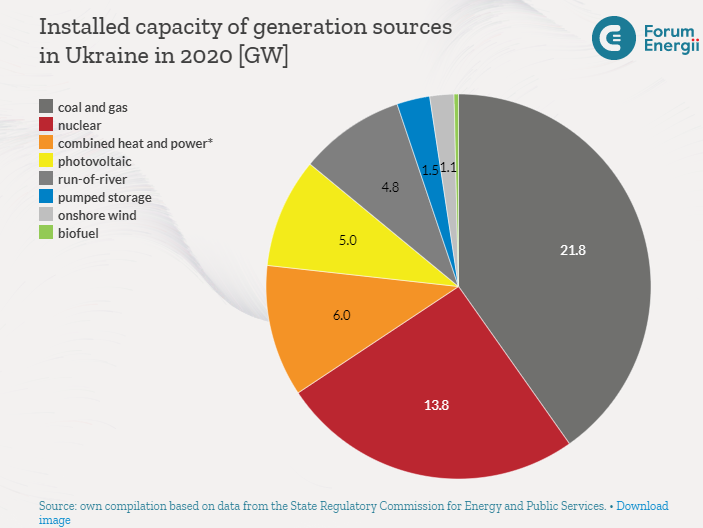
Source: Olga Sushyk, Deputy Director of the Centre for European Studies at the Educational and Scientific Institute of Law, and Taras Shevchenko National University of Kyiv: “Ukraine’s Power System: Power and War”, published on March 17, 2022.
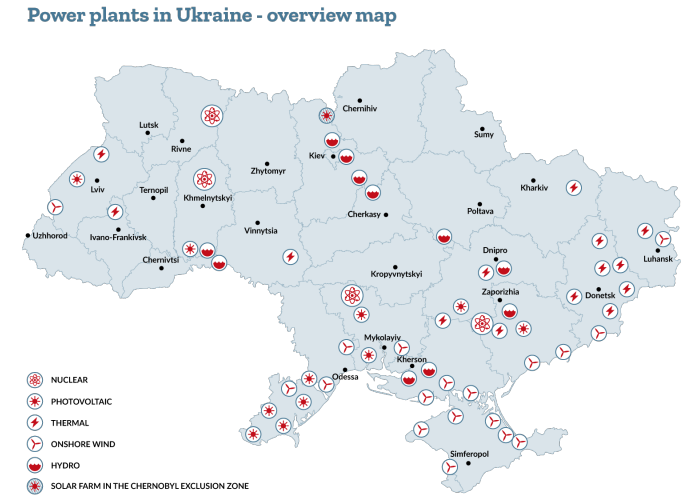
Source for enlarged view: file:///D:/Backups/Downloads/
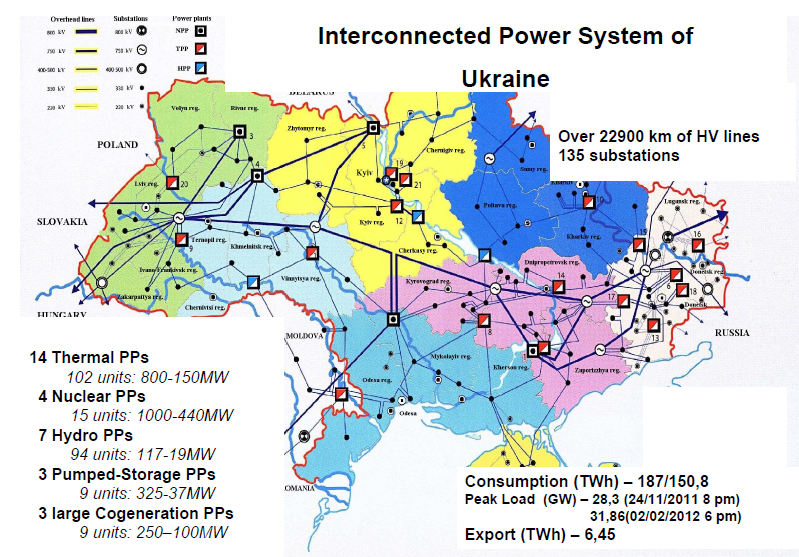
Source: Lyudmila Vlasenko, Head of Electricity Sector Development Unit, Ukrainian Ministry of Energy and Coal Sector – report titled “Power System of Ukraine: Today and Tomorrow”, July 2013. Since July of this year DTEK, the generation company owned by Ukrainian oligarch Rinat Akhmetov, has reported that “about 90% of Ukraine's wind capacity and 30% of solar parks are offline because they are in occupied territories.”
The Sushyk-Shevchenko report says that “due to damage to the electricity infrastructure, as of March 16, 2022, more than 1,679 Ukrainian localities remained without electricity – that’s about 928,000 consumers. The worst situation with electricity supply is in Sumy, Chernigov, Nikolaev, Kiev, and Donetsk regions.”
An earlier background briefing paper from the International Energy Agency (IEA), dated 2021, confirms the pre-war details. Here’s IEA’s backgrounder on Ukrainian electricity generation, apparently as of 2018.
The IEA also publishes daily updated charts of the collapse of Ukrainian electricity production; these are based on data supplied by Ukrenergo. These charts show the losses as of October 9.
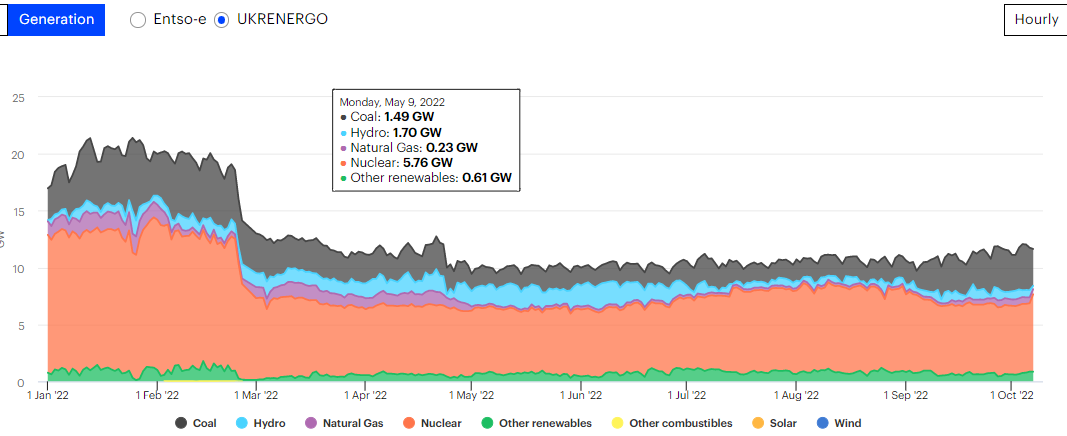
The same source also shows this chart of Ukrainian electricity demand; demand responds to the cutoff of coal, gas and nuclear fired generating plants by increasing use of domestic electrical heaters and back-up electrical generators.
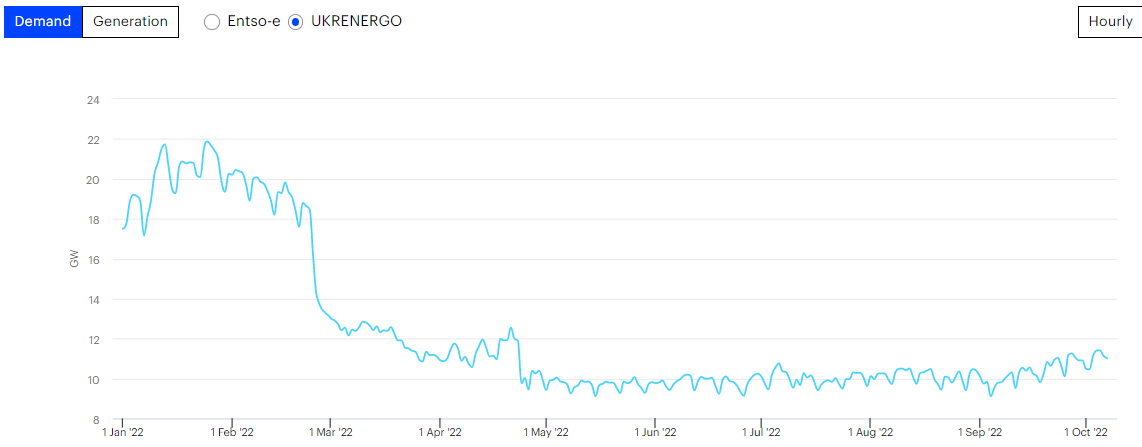
Source: https://www.iea.org/
Since 2014 Ukraine has lost a third of its energy generation which had been located in the breakaway Donetsk and Lugansk regions. Another 10 power plants were lost in 2014-2015, and seventeen more in 2022, according to a new assessment publishedlast Friday in Vzglyad of Moscow by Nikolai Storozhenko.
“Zaporozhye NPP [Nuclear Power Plant] stands out among them, of course. But this does not mean that the others are not worth attention. For example, the Zaporozhye thermal power plant (Energodar) has an installed capacity of more than 3,500 MW and can potentially produce 23-25 billion kWh (the annual plan for the NPP for 2022 was 37 billion kWh). In other words, the loss of this energy supply is a hole which, practically, the Ukraine can do nothing to close, and which will largely determine the problems of the Ukrainian winter of 2022/23.”
“Ukraine lost another 4% of electricity generation as a result of the fighting from February to September, according to the assessment of the National Council for the Restoration of Ukraine. However, it is obvious that these data do not take into account the blows to the energy infrastructure which were inflicted on September 11-12 (Kharkov CHPP-5, Zmievskaya CHPP, Pavlodar CHPP-3, Kremenchug CHPP). In general, the damage and reduction in the capacity of the energy system looks enormous for Ukraine and it is not entirely clear how Zelensky manages to sell electricity to Europe against this background.”
“But, firstly, sales [to Europe] will soon stop, which Zelensky has already warned Europe about, declaring recently: ‘We will not have enough volume to heat our homes, and this time is approaching.’ Secondly, Ukraine’s energy system is losing power simultaneously with a decrease in consumption…Yury Korolchuk, an expert at the Institute of Energy Strategies [Kiev], is urging consumers to be ready for five to six-hour rolling blackouts. Rolling blackouts are not news for Ukraine, but the realities of the last few years. Moreover, this year in the reports on the procurement of fuel for the winter, firewood began to appear…and the mayor of Lvov said in August that the city is buying and stocking wood for fuel.”
“What about gas supply? In the summer, Naftogaz asked for several billion dollars to purchase 5-7 billion cubic meters of gas – to bring reserves to 19 billion cubic meters. But there was no money for this – and to date, only 14 billion cubic meters have been accumulated. On the one hand, the situation for gas is about the same as with electricity: consumption is falling. Kherson, Zaporozhye, Donetsk, Lugansk and Kharkov regions are either completely written off…, or their supplies will be cut to a minimum. “In most cities of Kharkov, Donetsk, Nikolaev, Sumy, Chernogov regions and Zaporozhye there will be no heating. There will be no gas in winter, there will be light periodically — such a frightening forecast was published in the Telegram channel…half of this source’s forecasts come true – and they shout loudly about them. The second half does not come true – and no one remembers about them.”
“But in this case, the forecast is not groundless….[Ukrainian state] Naftogaz is delaying the conclusion of gas supply contracts with the gas distribution companies in the Kharkov and Dniepropetrovsk regions. At this point, it is worth remembering how, back in early summer, Zelensky’s office directly told the residents of the Donetsk region: go wherever you want, there will be no heating in winter.”
“In other words, the Ukrainian strategy is something like this. There are the combat areas and those adjacent to them. There the population has already dispersed or has greatly decreased; there is a risk of attacks on the facilities themselves and fuel depots. So, it is in these areas that it will be hardest to winter. It will be more comfortable for Kiev which has its own thermal power plants and there is an opportunity to add power from western Ukrainian nuclear power plants, and for the Galician region of western Ukraine [Lvov]. Also, there are about three to four million internally displaced people in Ukraine who have resettled mainly in these regions. Who should be kept without electricity and gas: the half-empty areas of the Zaporozhye region or Kiev? The choice is obvious.”
This is how the Ukrainian energy experts view their choice from Kiev. The strategic options for the Russian General Staff and Kremlin remain secret, if not undecided.
In the aftermath of the Crimean Bridge attack, Moscow television figures like Vladimir Soloviev have broadcast calls to extend the military campaign westward to Lvov and the Polish border. “It is obvious,” Soloviev said on Saturday, “that the NATO command took part in the development of this [Crimean Bridge] sabotage… What is our plan? Not to follow the enemy’s scenario, but to disrupt their plans, striking unexpected blows in directions where the enemy is not anticipating them. Ukraine should be plunged into dark times. Bridges, dams, railways, thermal power plants, and other infrastructure facilities should be destroyed throughout the territory of Ukraine. There should be no administrative office building operating in both Kiev and Lvov. And not only that.”
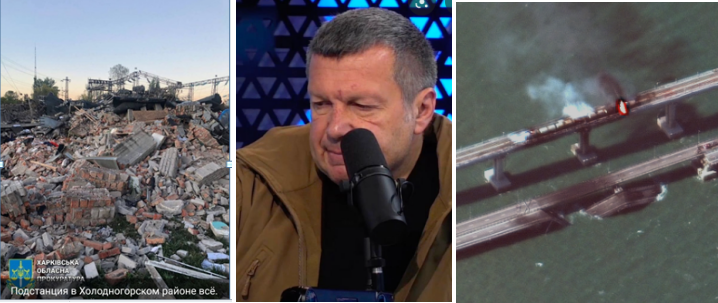
Left: a screen shot of a Kharkov substation after the September 11-12 attacks. Centre: Vladimir Soloviev, Moscow broadcaster and advocate for escalation. Russian and Crimean government officials are quieting the tone by announcing that train traffic on the Crimean Bridge has already resumed; that one road span is undamaged and will resume operation shortly; and replacement of the damaged road span will follow.
A combined US and European Union (EU) plan to link the Ukrainian electricity grid to the EU system, and thus provide supply back-up in case the Ukrainian grid was attacked by the Russian Army, has already failed. A US publication headlined the attempt “The Race to Rescue Ukraine’s Power Grid From Russia”; click to read.
“The test was years in the making, one of the final rituals in a drawn-out courtship between the Ukrainian and European power grids known as “synchronization.” But before it could join with Europe, Ukrenergo first had to prove it could keep the lights on without its connections to Belarus and Russia—in ‘island mode.’ The plan was to reconnect with its neighbours after a few days. Then in 2023 it would switch on the links with Europe.”
“That’s not what happened. Instead, on February 24, the same day as the test, Russia invaded. Since noon that day, Ukraine—in coordination with its southern neighbour Moldova—has been powering itself solo. It’s a balancing act. Changing where the power comes from and where it goes means some lines suddenly get clogged with electrons while others dry up. It can be difficult to maintain balance for any length of time. So far, the Ukrainian grid is humming along at a frequency of 50 Hertz—stable, in other words—a Ukrenergo spokesperson told WIRED by email. But it’s risky to continue that way indefinitely, especially during a war. When stuff breaks in the power grid, the whole system has to absorb the shock and rebalance. And right now, a lot is breaking across Ukraine…Last week, Kadri Simson, the European commissioner for energy, said the group representing the region’s transmission operators, will come to the rescue, potentially within weeks.”
This was wishful thinking on the part of the Latvian official in Brussels. For Simson’s record of faking on the EU’s gas substitution schemes, and the Russian response, read this report from October 2021.
The assessment of the North American expert on military operations against energy infrastructure focuses on the Russian side’s strategy until now, before considering the military options for the future. In addition to covering up the evidence of power generation losses by the Ukrainians which the source reports from Urkrenergo and IEA, he says the Russians have limited their attacks until now to “a form of reconnaissance by force. Their purpose, he believes, has been to determine what generating capacity remains, what can be repaired, how to interdict the human repair logistics, what is irreparably lost, and then to attrite the remaining Ukrainian materiel and human resources as the winter season approaches.”
“It appears to me that the Ukrainians are extremely hard-pressed to maintain and restore their electrical grid, most especially in the eastern regions. They are just as concerned to the point of adding and testing back-up generators at key nodes of the grid, especially in Kiev. By the way, the precedent for the Russian General Staff and Kremlin for destroying a country’s electrical grid was set during the NATO bombing of Serbia and then by the US air bombing of Iraq.”
For a history of US Air Force (USAF) strategy in attacking electric generation and distribution grids, read this USAF University thesis, entitled “Strategic Attack of National Electrical Systems”, dated 1994: “The USAF has long favoured attacking electrical power systems. Electric power has been considered a critical target in every war since World War II, and will likely be nominated in the future… The evidence shows that the only sound reason for attacking electrical power is to affect the production of war materiel in a war of attrition against a self-supporting nation-state without outside assistance.”
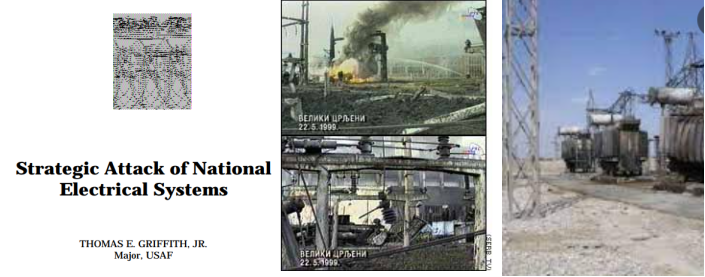
Left: Major Thomas Griffith’s USAF study of 1994. Centre: Iraqi electric relay unit bombed by the US Air Force in Operation Desert Storm in 1990-91. Right: Serbian generating plant damage after the USAF and European bombing campaign of May 1999.
The western military source again: “War is war, whether you want to use terms like hybrid war or proxy war. It means destroying the enemy’s capacity to make war. Shutting off the power in the rump Ukrainian state will do just that to the Ukrainians. If they then start to flee for refuge to Poland and Germany, this will be a disaster unparalleled in recent European history. Just the attendant collapse in telecommunications will make the place a madhouse. You can well imagine the rest. Already there are queues for water in Nikolaev, and who knows where else. How does queueing for water, if there is any, in temperatures of minus-20C to minus-40C sound? This won’t be like the blackouts from US sanctions and attacks in Cuba or Venezuela – there they didn’t have to worry about freezing to death, the pipes bursting, or irreparable damage being done to billions of dollars’ worth of pumping, electrical, and other equipment due to freezing.”
“How many people realize that a sulphur hexafluoride (SF6) circuit breaker, commonly used in electrical substations, requires an electric heating blanket to be functional in sub-zero weather? Most westerners don’t. They are common in high voltage substations which ultimately feed the grid lines with power. In the Ukrainian case, I suspect there is a mixture of those and older style oil circuit breakers (OCB), along with oil-filled large power transformers (LPT), which are essential to electrical distribution. And guess where most of the oil comes from to fill these devices?”
“I suspect that most of Zelensky’s officials and officials in the supporting EU governments have persuaded themselves with their own propaganda. They aren’t daring to think through these questions, any more than they care to understand that the housing of the pumps delivering their water and treating their sewage will freeze and split apart if they are not heated via electrical means. Even if the gas is on — and it won’t be — electricity is needed to ignite, then control, furnaces. How many of these officials understand the long lead times, compounded by manufacturing shutdowns due to high energy costs, which you must have to replace and restore everything?”
“Who then will ‘stand with Ukraine’ when the gas and electricity rationing and unpayable consumer bills roll over the Ukrainian border and into Poland, Germany, France, and the UK, as they are already doing?”
“The Russians have been hitting the Ukrainian electrical distribution system for months now. As we know, they started with the rail traction power yards which are largely branches of the wider electric grid. Now they have moved to the substations and so-called ‘thermal power’ plants, hitting them in what seems to be pellmell fashion. I expect that the Russians are gathering intelligence now on repair times, re-equipment availability, deliveries, repair crew composition and coordination.”
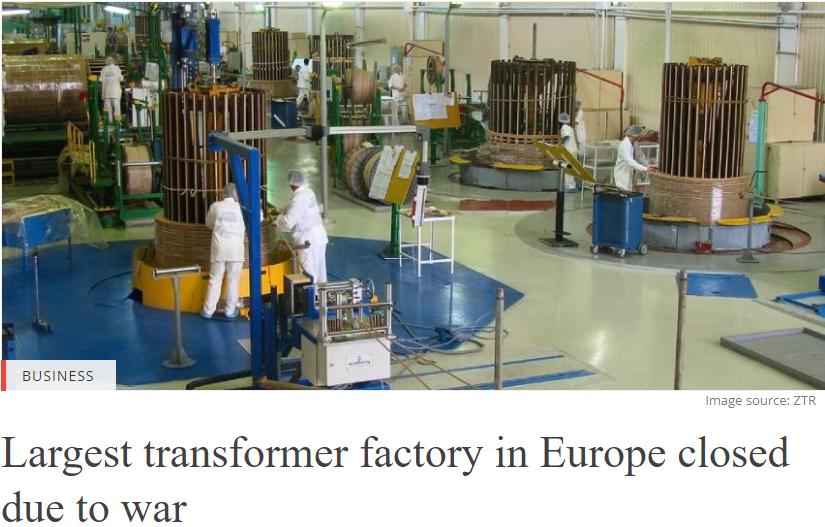
Source: https://transformers-magazine.com/
“So let’s imagine this. Winter arrives. The power is cut in Kharkov, Dnepropetrovsk, Pavlovsk, Nikolaev etc. and due to the unavailability of spares, repair crews, respite from attack, or all three, the outlook for the power outage is indefinite. What do people do? They migrate to where there is power, running water, heat etc… For millions this means west. So off they go. And when enough of them get there, bam! the power goes off there too.”
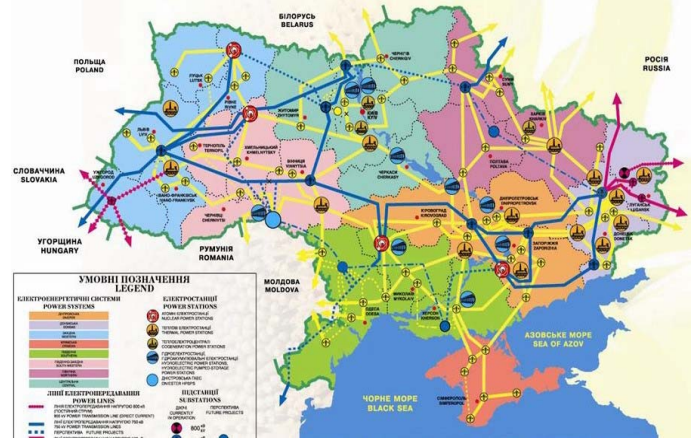
Source for enlarged view: https://eneken.ieej.or.jp -- page 6.
Reading the grid maps of the Ukraine, the source says “it is obvious that the real vulnerability, in my estimation, lies in the approximately 88 substations for 330kV distribution and 33 substations for 220kV distribution. Note the nodes or junctions. Those are substations connecting the distribution lines which crisscross the Ukraine. These substations contain large power transformers, switchgear, DCS equipment [Distributed Control System] and other power quality and control equipment, spares etc. Widespread coordinated strikes on these substations will quickly overwhelm the Ukrainian ability to effect repairs and re-balance the loads on the generation stations. This will create a cascade effect whereby overloaded power plants, and distribution gear will ‘trip out’ over wide swathes of the country – if the protection between the Ukrainian and EU grids does not operate in time, or there is wild voltage/frequency oscillations there could be large interruptions in the EU countries being fed from Ukrainian sources.”
“Any repair efforts will also be severely hampered, if not crippled, if utility yards where spare cables and other gear, as well as vehicles (bucket and line trucks, cranes etc.) are stored and parked are struck. Personnel losses among the finite number of utility crew members due to follow-up attacks and the inevitable mishaps that come with interacting with damaged or compromised high voltage electrical equipment, will quickly mount. If the attacks are launched during the hard winter months, the impact will be exponential, increasingly unmanageable and catastrophic as the hours go by.”


